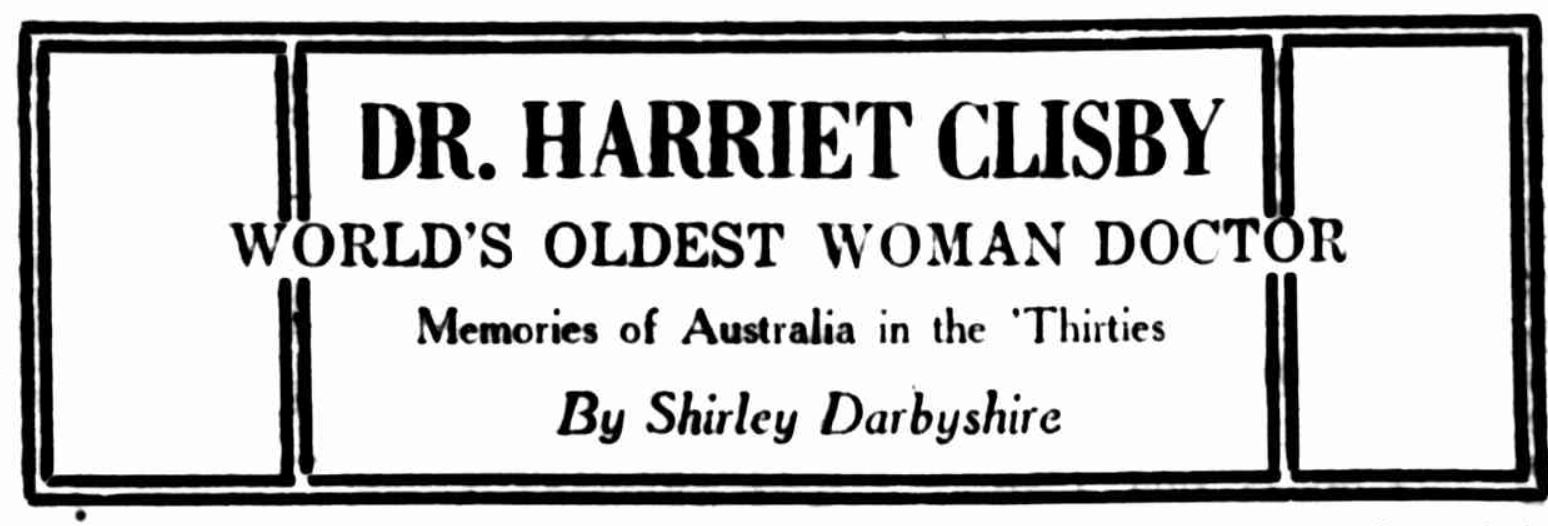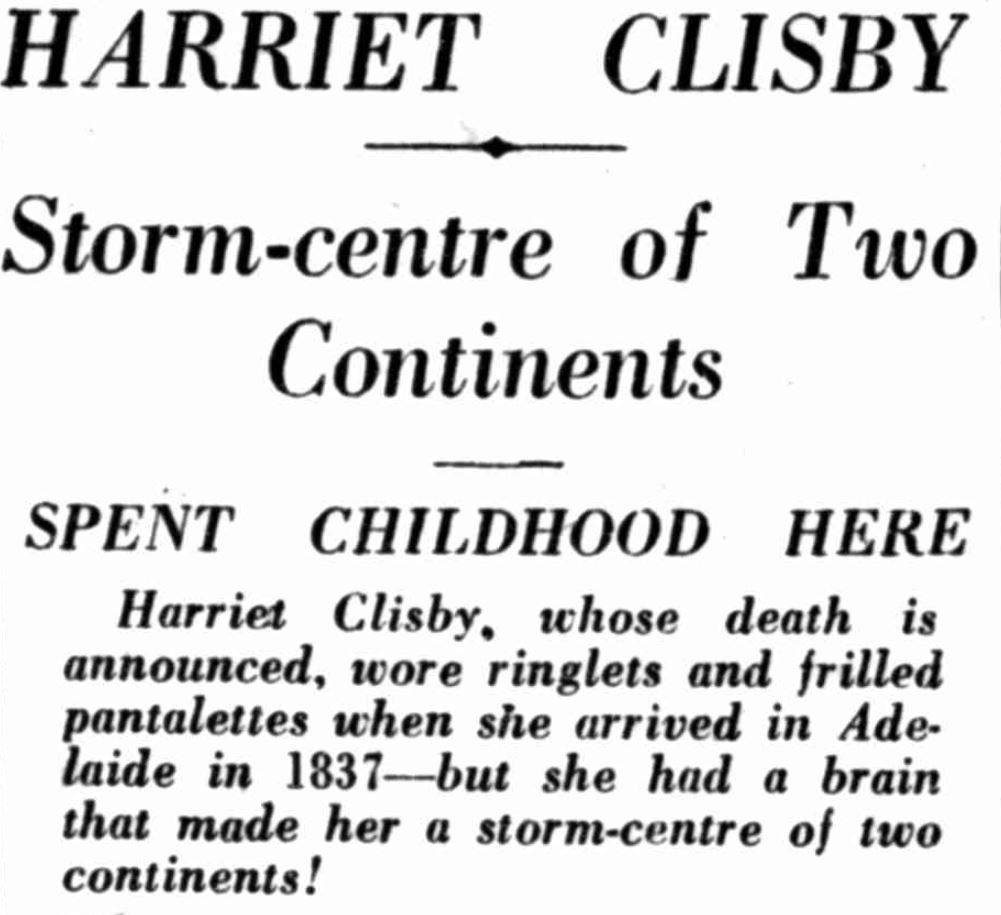HARRIET CLISBY
Storm-centre of Two Continents
SPENT CHILDHOOD HERE
Harriet Clisby, whose death is announced, wore ringlets and frilled pantalettes when she arrived in Adelaide in 1837—but she had a brain that made her a storm-centre of two continents!
There was nothing early Victorian about the woman, who left a pioneer music shop in Adelaide to become one of the world’s most famous woman doctors. She should have, been called “Adelaide” after the gentle queen when she was born in London on August 31, 1830. Her mother wanted that name, but the head of the house wanted Harriet—and he won, as the head of the house generally did a century ago. It took the Clisbys five months to reach Adelaide. Harriet early showed that hers was to be no stay-at-home life. Her father kept a music shop in Rundle street—opposite what is now the Oriental Hotel—but the gentle art was not for Harriet.
[continued]
News, 6 May 1931
Her father, with his family, came to Australia in 1837, and settled at Adelaide, which was then a small clearing in the bush.
“We slept in hammocks for a week or two,” Dr. Clisby said in an interview on her 100th birthday, “wakening to the screech of cockatoos and parrots which looked down at us in their hundreds from the branches above. One cow, which belonged to the Governor, afforded the little community its only milk supply. “We lived in tents for a year or so, felling trees to clear the land, and then we all took a hand in building a little pise, or mud hut, which had a reed roof. We lived there till I was about nine, and then came the long trek to the bush. We had to wait for two drays which my father had ordered, and for some cattle to come overland, but at last, with our four bullocks and our little flock of geese, goats, and one pig, we set out, my mother perched on the top of all our small belongings piled on one of the drays. When we reached the bush, the two carpenters whom father had sent on ahead had built us a nice little house of eucalyptus bark. It had no windows, but mother had some beautiful curtains which shut out the night. We had to make air our own furniture, of course. Our seats were simply logs of wood, each one cut to the size of the other.”
….
When Harriet was 15 the family returned to Adelaide, where efforts were made to make her forego her short prairie frock for fashionable long skirts. She was the despair of fashionable dressmakers, and gave in only because her mother wanted it. She had learnt shorthand when she was 14, and at 28 was running a community home in Adelaide for the rescue of women prisoners, and editing the first phonographic magazine for Sir (then Mr.) Isaac Pitman, when Dr. Elizabeth Blackwell published her first pamphlet about medicine for women.
“I rushed to a dear doctor friend of mine,’ Harriet Clisby recalled, ‘and asked him if I should ever make a good doctor. He said I had many of the qualities of a good physician, and there and then started me on anatomy and physiology!”
[continued]
Chronicle, 24 October 1940

Dr. HARRIET CLISBY, the oldest woman doctor in the world, celebrated her 98th birthday at the end of August. The most impressionable years of her life were spent in Australia. Her Australia was very different from the Australia we know nowadays. It is difficult sometimes to recognise present-day Australia, when listening to the memories of Dr. Clisby. To her the virgin country of the 1830’s is much more real than the country of modern cities which is known to-day.
In 1837—the year in which Queen Victoria came to the throne—Harriet Clisby left England for Australia with her parents. She was aged seven years at the time, and she can remember the voyage perfectly well. They sailed in the Rajastan, and the journey took five months. I ventured the opinion that the voyage in the sailing ship must have been uncomfortable. Dr. Clisby scouted the idea. “It was lovely,” she said. “We encountered plenty of storms, but I enjoyed them and I loved watching the dolphins and the porpoises and the whales. Everything we ate was tinned. The captain kept a few fowls and goats so there was a little fresh meat and milk, but they were reserved for special occasions. As a general rule, we lived on tinned milk and tinned pork and beef both very salty, and tinned potatoes, which were put into water and mashed.”
[continued]
The Argus, 24 November 1928
Miss Shirlet Darbyshire, whom Australians last met as Mrs. Laurence Meynell, when she revisited the land of her birth two years ago, has acknowledged that the portrait of the woman doctor who is the heroine of her latest novel, “Henrietta Condon. M.D.,” is largely drawn from life. Nor does it require a great deal of imagination to realise that the name Henrietta Condon only very thinly veils the identity of one of the earliest woman doctors, Harriet Clisby, who died only a few years ago at the great age of 100.
The Age, 8 December 1936
Trove entry for “Henritta Codon, M.D.”
More Information
Australian Dictionary of Biography
Obituaries Australia
The Interpreter: an Australian magazine of science, literature, art etc, Part 1, Janaury 1861
Representative women of New England: Boston Women’s Educational and Industrial Union (from WikiSource)
Boston Women’s Heritage Trail: Chinatown/South Cove: #18: Site of Women’s Educational and Industrial Union

